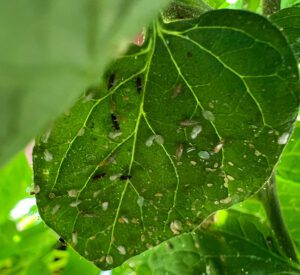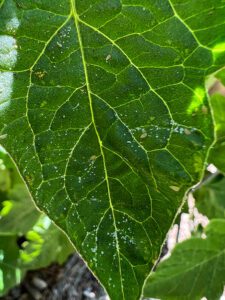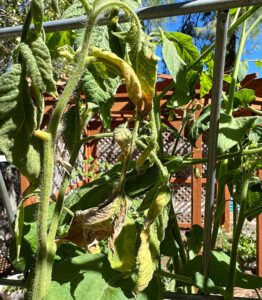Tomato-Potato Psyllids
(NOTE: All photos are courtesy of Jennifer Wilkerson – click on them to view larger image.)
Latin name: Bactericera cockerelli
Size: Adults are about 1/16” long
Color: The adults look like a miniature version of a cicada! They have clear wings, black and yellow bands on their abdomen, and red eyes. They also have some white markings on their thorax.
Life cycle: Female psyllids lay pale eggs on stalks that are attached to leaf edges or leaf undersides. The nymphs hatch 1-2 weeks later. Their bodies are similar in appearance to scale insects and have flat green to orange bodies. The nymphs go through 5 instars (stages in their life cycle), then transform into winged adults. Nymphs primarily feed on the leaf undersides. There are typically 4 or more generations per year. Tomato-potato psyllids are not able to overwinter in regions that have harsh winters.
Signs of their activity: Stunted plants; yellow leaves; curled leaves; minimal to no fruits or abnormally small fruits; also misshapen and prematurely-sprouting potato tubers. All of these symptoms are caused by a bacterial toxin (Candidatus Liberabacter solanacearum) that psyllids inject into the foliage while they are feeding. The symptoms go by the names of “psyllid yellows” or “vein greening.” It’s important to note that the nymphs secrete waxy pellets known as “psyllid sugar” because they have the appearance of granules of sugar; this is a very good way to spot their presence on a plant. The psyllids are more frequently seen in the lower, shady areas of plants.
Typically seen on: Primarily tomatoes and potatoes but also on other members of the nightshade family (Solanaceae) which includes peppers, eggplants, and tomatillos. In addition, the psyllids are attracted to weeds belonging to the nightshade family. I also learned that these pests are particularly attracted to ‘Yellow Pear’ tomatoes.
Controls: Monitor all nightshade family crops regularly. Hang yellow sticky traps (which you can buy or make) near the plants to detect that adult tomato/potato psyllids are active in the area. Apply spinosad, which is an organic product. Horticultural oils are supposed to be effective when sprayed onto the nymphs. Always follow the label directions.
Natural predators: Damsel bugs, ladybugs, minute pirate bugs. Unfortunately, by the time these natural predators go to work, the tomato/potato psyllids have already caused a lot of damage.

Notice all of the life stages of tomato-potato psyllids here, even the eggs on stalks along the leaf edge!
Additional information: Potato or Tomato Psyllids



